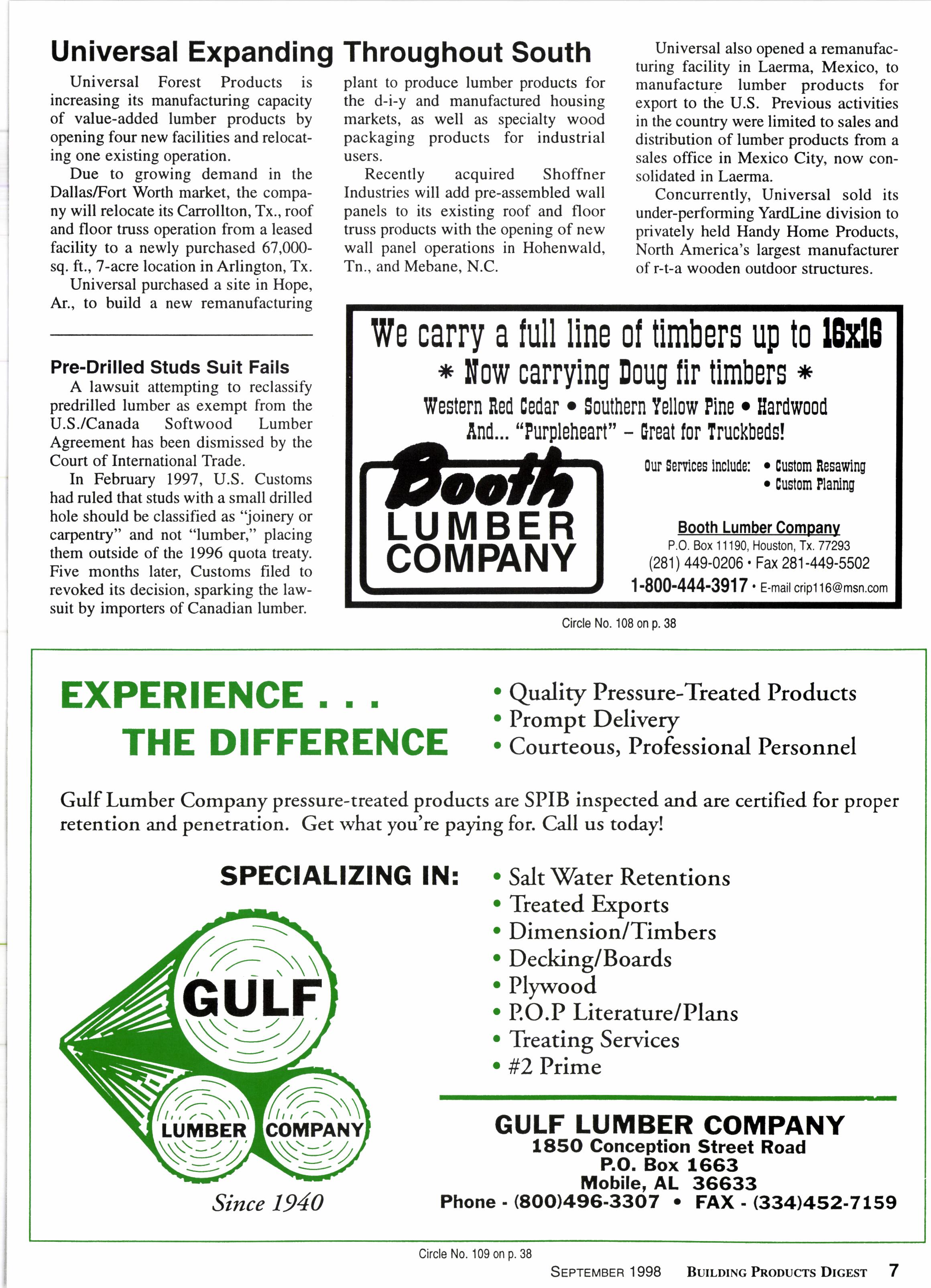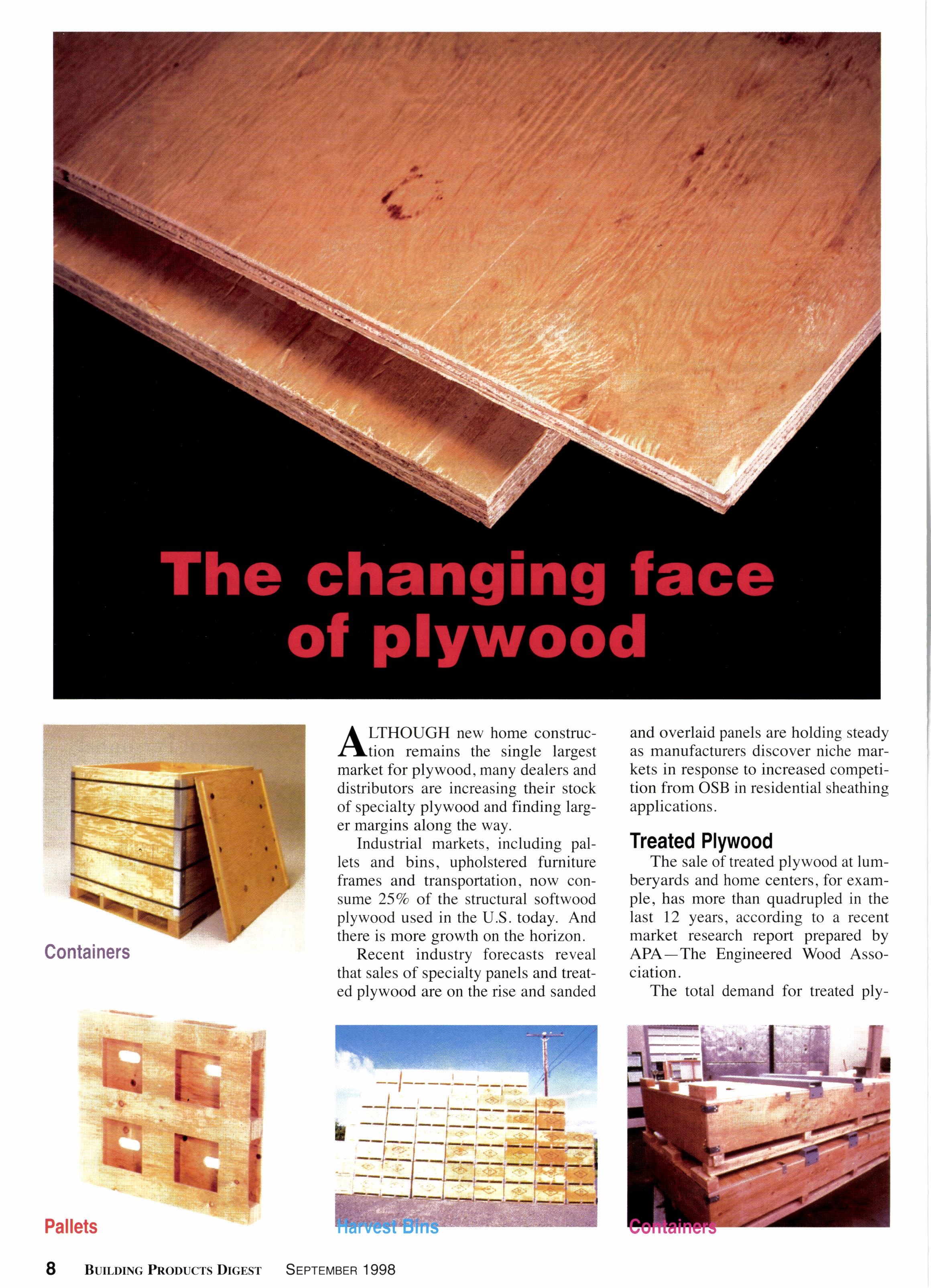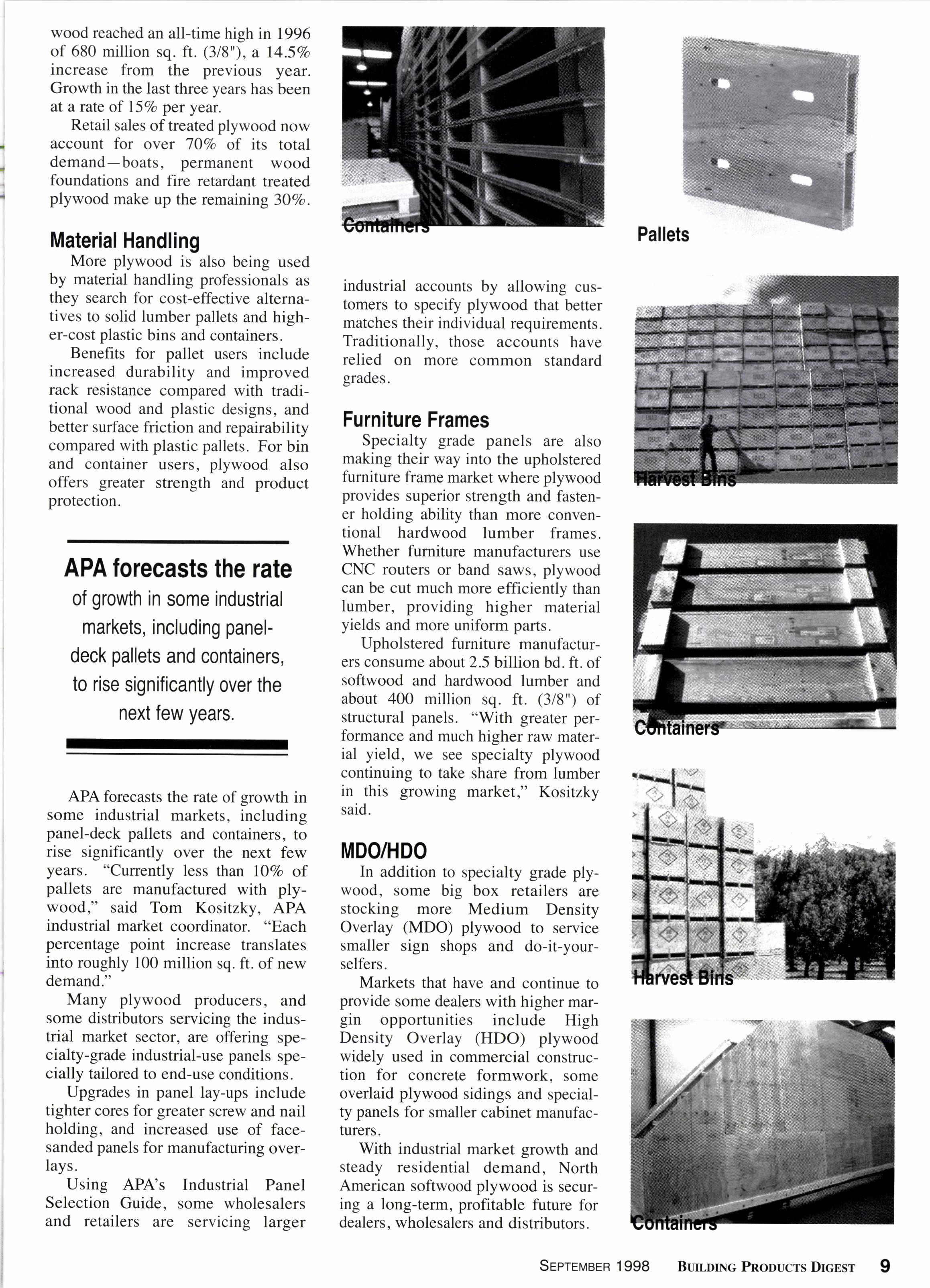
3 minute read
Universal Expanding Throughout South
Universal Forest Products is increasing its manufacturing capacity of value-added lumber products by opening four new facilities and relocating one existing operation.
Due to growing demand in the Dallas/Fort Worth market, the company will relocate its Carrollton, Tx., roof and floor truss operation from a leased facility to a newly purchased 67,000sq. ft., 7-acre location in Arlington, Tx.
Universal purchased a site in Hope, Ar., to build a new remanufacturing
Pre-Drilled Studs Suit Fails
A lawsuit attempting to reclassify predrilled lumber as exempt from the U.S./Canada Softwood Lumber Agreement has been dismissed by the Court of International Trade.
In February 1997, U.S. Customs had ruled that studs with a small drilled hole should be classified as "joinery or carpentry" and not "lumber," placing them outside of the 1996 quota treaty. Five months later, Customs filed to revoked its decision, sparking the lawsuit by importers of Canadian lumber.
plant to produce lumber products for the d-i-y and manufactured housing markets, as well as specialty wood packaging products for industrial users.
Recently acquired Shoffner Industries will add pre-assembled wall panels to its existing roof and floor truss products with the opening of new wall panel operations in Hohenwald, Tn., and Mebane, N.C.
Universal also opened a remanufacturing facility in Laerma, Mexico, to manufacture lumber products for export to the U.S. hevious activities in the country were limited to sales and distribution of lumber products from a sales office in Mexico City, now consolidated in Laerma.
Concurrently, Universal sold its under-performing Yardline division to privately held Handy Home Products, North America's largest manufacturer of r-t-a wooden outdoor strucfures.
Iile carry a full line of timbers up to IBlrIB {e Notll carrying Doug fir timbers {c
l,ltestern Red Cedar o Southern lellotlt line o Hardwood f,nd... "Purpleheart" l{eccnt indrrstn fnlcclsts rcr crLl thlt salc\ o1'spcciullr pancls uncl trclt cti pll l ootl ute on tltc risc lrrtrl sunrlctl attrl overlairl l)ilnels lfc Irolrlirrg :tearlr rrs llirnutlrclrrrcrs clise or cl nie hc nrar kcts rn rcsl)()nsc to incrcasecl conrpetitiott lirnr OSll in resirlcntial sltrrLtltirtg lpl)Iiclti()Jr\.
A |.l I l( )t (;l I l)r'\\ irorltc \'()n\tt'u\' fa,li,rn r'\'nlilir)\ llrr''irtllt' lrrlsc.t mlrkct lirr' plt ri ootl. ntrrr,r clclLlcrs ancl clistlibrrtot's llrc incfcl\ir)q tlrcir stock of syrce iuln plr l ocld antl l'inclirre lirrg cr nurrgirts along the l ur.
InrlLrstlirl nrirfkets. inelucliur: plillcts unrl bins. Lrpholstclcrl lirrnitLrre llitlllr'. illt(l lllrll\lr0llirlir)ll. llr)\\ .rrll\ur)rc l5'.i r)1' tl)c \tlr-lrtLrllll solt\\ ootl plrnoocl usecl ir) tlrc t.S. toclav. ,,\nd thcrc rs nl()re g11)\\ th on thc holizon.
Treated Plywood

Thc sulc ol trcutccl plr tt oorl ut lLrnrbcrr lrrcl: lind honrc ccntcrs. tbl crlLrnplc. hlrs nrorc thilr) clLrailrupled irr tlrc lust I I ,\ cr.ll'\. le r'()rdir)r 1() a fcfcnt nlrrkct lcseulch lcl)ort l)rcparcrl bt
,\[:A-Thc Enginccrecl \\ixrcl,\sso ciution. 'fhc totul clcnlrnrl for trculed pl,r, wood reached an all-time high in 1996 of 680 million sq. ft. (3/8"), a l4.5%o increase from the previous year. Growth in the last three years has been at a late of l5%o per year.
Retail sales of treated plywood now account for over TOVo of its total demand-boats, permanent wood foundations and fire retardant treated plywood make up the remaining 307o.
Material Handling
More plywood is also being used by material handling professionals as they search for cost-effective alternatives to solid lumber pallets and higher-cost plastic bins and containers.
Benefits for pallet users include increased durability and improved rack resistance compared with traditional wood and plastic designs, and better surface friction and repairability compared with plastic pallets. For bin and container users, plywood also offers greater strength and product protection.
APA forecasts the rate of growth in some industrial markets, including paneldeck pallets and containers, to rise significantly over the next few years.
industrial accounts by allowing customers to specify plywood that better matches their individual requirements. Traditionally, those accounts have relied on more common standard grades.
Furniture Frames
Specialty grade panels are also making their way into the upholstered furniture frame market where plywood provides superior strength and fastener holding ability than more conventional hardwood lumber frames. Whether furniture manufacturers use CNC routers or band saws, plywood can be cut much more efficiently than lumber, providing higher material yields and more uniform parts.

APA forecasts the rate of growth in some industrial markets, including panel-deck pallets and containers, to rise significantly over the next few years. "Currently less than lOVo of pallets are manufactured with plywood," said Tom Kositzky, APA industrial market coordinator. "Each percentage point increase translates into roughly 100 million sq. ft. of new demand."
Many plywood producers, and some distributors servicing the industrial market sector, are offering specialty-grade industrial-use panels specially tailored to end-use conditions.
Upgrades in panel lay-ups include tighter cores for greater screw and nail holding, and increased use of facesanded panels for manufacturing overlays.
Using APA's Industrial Panel Selection Guide, some wholesalers and retailers are servicing larger
Upholstered furniture manufacturers consume about 2.5 billion bd. ft. of softwood and hardwood lumber and about 400 million sq. ft. (3/8") of structural panels. "With greater performance and much higher raw material yield, we see specialty plywood continuing to take share from lumber in this growing market," Kositzky said.
MDO/HDO
In addition to specialty grade plywood, some big box retailers are stocking more Medium Density Overlay (MDO) plywood to service smaller sign shops and do-it-yourselfers.
Markets that have and continue to provide some dealers with higher margin opportunities include High Density Overlay (HDO) plywood widely used in commercial construction for concrete formwork, some overlaid plywood sidings and specialty panels for smaller cabinet manufacturers.
With industrial market growth and steady residential demand, North American softwood plywood is securing a long-term, profitable future for dealers, wholesalers and distributors.
Company
(including number of OSB planls)










